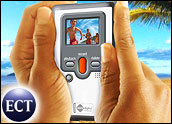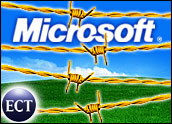
Emotiv Systems unveiled a new gaming headset that uses thoughts and movement to control on-screen character movements.
The San Francisco-based peripheral company demonstrated the Emotiv EPOC at the Wednesday kickoff of the Game Developers Conference, the annual confab where developers, designers and hardware companies showcase their wares. The EPOC is a wireless device that uses sensors to detect such motions as horizontal eye moments, furrowed brows and winks along with actions such as pushing and pulling motions to control virtual characters.
The device, which will retail for US$299, will ship with Emotiv-specific software that allows users — and game developers — to explore how such a device may change game play. The company also announced a partnership with IBM, which will explore non-game-related uses for the device in business markets and virtual worlds.
“The use of [brain-computer interface] technology represents a potential breakthrough in human-machine interfaces, changing the realm of possibilities not only for games, but in the way that humans and computer interact,” said Paul Ledak, vice president of IBM’s Digital Convergence.
Moving Past the Mouse
The EPOC doesn’t use groundbreaking technology — there are a host of peripheral devices that use sensors and motion-detection, it does, however, reinforce the shift in game-specific input devices that have slowly migrated from the QWERTY keyboard and mouse.
Sony’s EyeToy, which uses cameras and sensors to put placers in the game, and Nintendo’s Wii controller, which uses sensors and motion for game control, are two of the more popular devices.
The problem facing most new peripherals, though, is the need to be fully integrated into software production to reach full functionality, said Ruben Mookerjee, director of product marketing, Logitech’s Gaming Line. That puts devices such as the EPOC at a disadvantage.
Developers at Logitech, one of the premiere game peripheral developers, spend more time working with software engineers at other companies than they do developing prototype devices, Mookerjee told TechNewsWorld.
“We tend to develop the hardware around the software,” said Mookerjee “The actual technology is easy. We can make a proof-of-concept device in a short period of time. Then we have to tune it to work with the software.”
Open Development
Unlike Logitech, which makes hardware for software companies, Emotiv hopes to attract software makers to its hardware. To do that, the company also released two developer kits, allowing programmers access to a complete environment for creating and testing the use of the headset with other software applications.
“By providing widespread access to these development tools, we aim to make the introduction of brain-computer interface technology into games and other applications seamless and cost-effective,” said Nam Do, CEO of Emotiv Systems.





















































